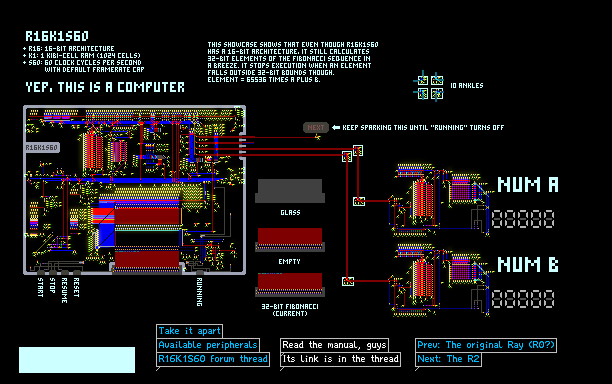R16K1S60 by LBPHacker

*** Update #9: Add links to predecessor and successor *** See thread and manual link in the save. ***
fastest
subframe
programmable
16bit
processor
7segment
electronics
electronic
computer
magic
Comments
-
LBPHacker 12th Aug 2016
 *** ATTENTION *** A bug has been fixed in R16K1S60. The instruction TEST would behave like the instruction AND and would store the result in the primary operand. Not anymore. *** Please update your R16K1S60 copies. ***
*** ATTENTION *** A bug has been fixed in R16K1S60. The instruction TEST would behave like the instruction AND and would store the result in the primary operand. Not anymore. *** Please update your R16K1S60 copies. *** -
QuanTech 11th Aug 2016
 even when i go down to 20fps, this thing is still insanely fast!
even when i go down to 20fps, this thing is still insanely fast! -
LBPHacker 4th Aug 2016
 Thanks! Please note that 4,533,709,441 is not actually an element of the Fibonacci sequence though. As the text in the save says, element = A * 65536 + B. I don't have a 32-bit display so I used to 16-bit ones. That means the number you're referring to is actually 2,971,215,073 which, by the way, *is* in the 32-bit number range unlike 4,533,709,441.
Thanks! Please note that 4,533,709,441 is not actually an element of the Fibonacci sequence though. As the text in the save says, element = A * 65536 + B. I don't have a 32-bit display so I used to 16-bit ones. That means the number you're referring to is actually 2,971,215,073 which, by the way, *is* in the 32-bit number range unlike 4,533,709,441. -
sentinal-5 3rd Aug 2016
 Any computer built in a two dimensional cellular automator that can run the fibonacci sequence up to 4,533,709,441 is genius in my book. i wish i could +1 more than once because i'm still absolutely blown away by this. congratulations.
Any computer built in a two dimensional cellular automator that can run the fibonacci sequence up to 4,533,709,441 is genius in my book. i wish i could +1 more than once because i'm still absolutely blown away by this. congratulations. -
QuanTech 1st Aug 2016
 lol, my laptop is so crappy that R16K1S60 is actually 20Hz on it...
lol, my laptop is so crappy that R16K1S60 is actually 20Hz on it... -
LBPHacker 1st Aug 2016
 Nope. Not at all what I mean.
Nope. Not at all what I mean. -
QuanTech 1st Aug 2016
 and you would also have to make the display be 120Hz
and you would also have to make the display be 120Hz -
LBPHacker 31st Jul 2016
 Sure. It's a bit messy though. Although Schmolendevice is the one to ask when it comes to multicore computing, I can tell you that it's pointless to have multiple cores when what you're doing cannot actually be done on multiple cores (ie. the task is not parallelizable). Adding up 6, 2 and 8 is not really parallelizable, since you need the result of the first addition to get started with the second. Adding up 6, 2, 8 and 7, on the other hand, can still be done in two additions' worth of time.
Sure. It's a bit messy though. Although Schmolendevice is the one to ask when it comes to multicore computing, I can tell you that it's pointless to have multiple cores when what you're doing cannot actually be done on multiple cores (ie. the task is not parallelizable). Adding up 6, 2 and 8 is not really parallelizable, since you need the result of the first addition to get started with the second. Adding up 6, 2, 8 and 7, on the other hand, can still be done in two additions' worth of time. -
QuanTech 31st Jul 2016
 would it be possible to make a dual-core 120Hz processor?
would it be possible to make a dual-core 120Hz processor? -
camdood45 30th Jul 2016
 VERY cool +1
VERY cool +1